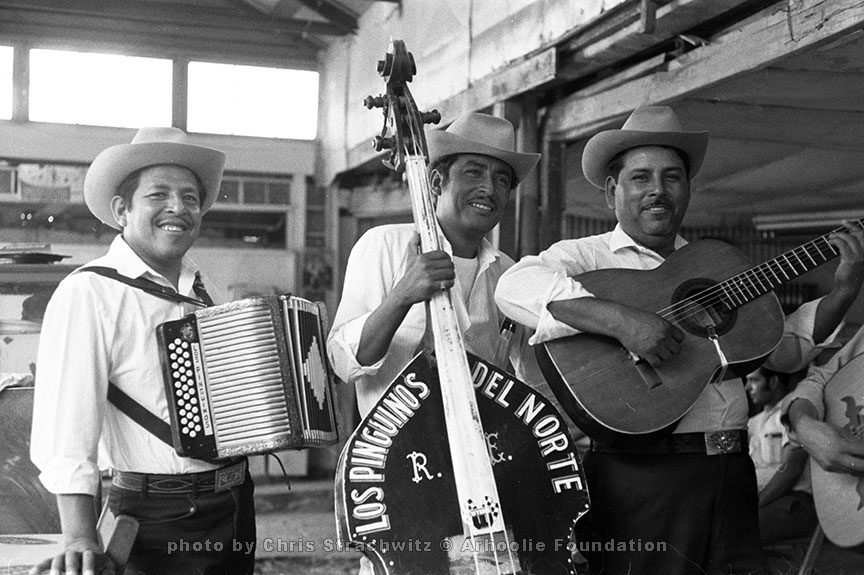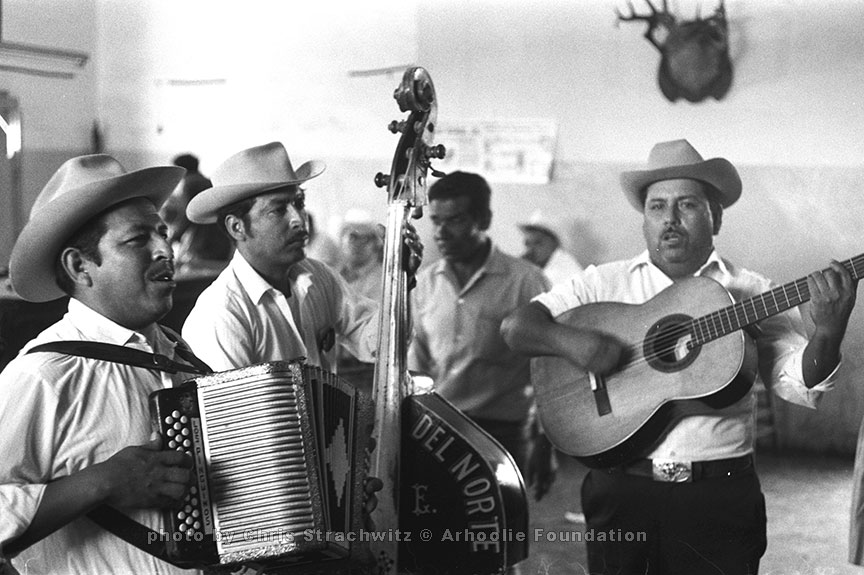Chris Strachwitz Remembers Los Pingüinos Del Norte
I believe when I first heard Mexican music on the radio, there was a little station in Santa Paula, which is very close south of Santa Barbara. And in the afternoons, I would sneak back into my room sometimes. No, that must have been when I was already a senior, or at least a junior. Yeah, so that was either ’50 or ’51. And I would sneak back into my room and turn on my radio. That was always my ear opener to the world. In the mornings I would listen to XERB and so on. Yeah, on XERB I never heard any Mexican music worth a damn because that was playing strictly hillbilly music at that time because Mexican music was not a salable product.” – Chris Strachwitz
This is an interview originally recorded for research purposes. It is presented here in its raw state, unedited except to remove some irrelevant sections and blank spaces. All rights to the interview are reserved by the Arhoolie Foundation. All photos by Chris Strachwitz. Please do not use anything from this website without permission. info@arhoolie.org
To learn more about Los Pingüinos Del Norte and other acclaimed Norteño musicians, check out the Chulas Fronteras documentary.
See below photo gallery for a transcript of the interview
Chris Strachwitz Interview Transcript:
Chris Strachwitz:
Okay. This probably happened when I was at the Cate School in Carpinteria, California.
That is, I believe when I first heard Mexican music on the radio. There was a little station in Santa Paula, which is very close south of Santa Barbara. And in the afternoons, I would sneak back into my room sometimes. No, that must have been when I was already a senior, or at least a junior. Yeah, so that was either ’50 or ’51.
And I would sneak back into my room and turn on my radio. That was always my ear opener to the world. In the mornings I would listen to XERB and so on. Yeah, on XERB I never heard any Mexican music worth a damn because that was playing strictly hillbilly music at that time because Mexican music was not a salable product.
And at that time I do remember that it was mostly mariachis, of course, with singers. Mostly duets, or whatever, and also solo singers, but I did hear some accordion music, which I assume was probably Santiago Jimenez because his records started coming out on Imperial. And as I learned later on Imperial and so on and Globe Records in the late ’40s.
But then it continued when I went to Pomona College, because we would hang out sometimes at a Mexican bar and then I was enthralled by the jukebox and I would play certain things, but I have no recollection as to what I was listening to.
But it was strictly a sideline. I liked it because it sounded very much like American country music except in Spanish. It had a very close relationship, especially the duet singing and so on.
And of course it also had mostly polka rhythm or waltz time, which I was also in a way familiar with, although people say, well, you have German, didn’t you hear a lot of that? No I didn’t.
Under Hitler, you only heard March music, everything was in March tempo, which was like punk music. (Mimicking drumming sounds) I mean, it was horrible.
Anyway, but it was attractive in a way, but it didn’t have much to do with Polkas, nor Waltzes. Of course, right after the war, I heard American Swing and all of that. Tommy Dorsey’s Boogie Woogie. When I was still in Germany before we came over here and on the American network radio stations and so on.
And so it all started blending together after that.
Tom Diamant:
So how did you end up in a Piedras Negras in 1970?
Chris Strachwitz:
That’s a pretty good question.
Okay, I had been driving to Texas and Louisiana, a number of occasions. I think the first time was in 1960, but there I drove with Bob Pinson on the Northern route because he wanted to go back to Dallas or Fort Worth.
But then in years, following that, I started driving the Southern route, which was Highway 66. This was before there were freeways. And I would take 66, I think that took you down through Bakersfield and then across Arizona, through Phoenix and so on.
And there, of course I always heard Mexican music. It was on all the stations that you would get. There was a little bit of it on the American side. And of course, once I started getting into Texas, there was XELO in Juárez, Chihuahua, that was pretty powerful station. And that was called, La Rancherita, I think. And so they played ranchera music.
And anyway, so I had been going through that area of South West, Texas for many years driving through and I heard so much of it. And I became of course, fascinated with the records that I encountered on the way through, because I was always a record collector, you know?
And I started picking up stuff that was obviously seemed to be of interest to my ears, like accordion players or duet singers with accordion and so forth. I really don’t know what I started with in that field. But I was well acquainted with it and also realized that there were lots of local labels that were recording it.
I really had no intention of joining the parade of companies to record this stuff, because I thought it was really being very well documented by all these local labels. Especially, I think I became aware of Falcon Records and Ideal Records because they were the most prolific ones on jukeboxes and so on.
And so finally, my recollection really is that this happened through our good friend, the late Archie Green, although he claims he does not remember that. But I think I did.
He told me about a young law student who had graduated from Harvard Law School named Jerry Abrams, who had moved to the Rio Grande Valley because he was very much, he got very much involved in the farm workers union movement and so forth. And I think Archie gave me an address or a phone number for him.
I contacted him, Jerry Abrams, and he was a very welcoming guy, and was totally enthused about the music in that area. And he said to me, this is my best of recollections, he said, “sometimes go to-“, maybe he was actually living in Eagle Pass. You see Eagle Pass is on this side of the river from Piedras, Negras in the state of Coahuila.
So, when we went there, he may have, no, I don’t think he took me there. But anyway, I think he had his law offices already in Eagle Pass, if I’m not mistaken. And somehow he also knew this guy, Rumel Fuentes, who was kind of a school teacher.
But anyhow, so I met both Jerry Abrams, and then Rumel Fuentes, and they were both very keen about this little Dueto that was the most active Conjunto Norteño at that time in Piedras Negras.
And they were called “Los Pingüinos Del Norte”. Even their name, this was such an attractive one, “the Penguins of the North”. And when you met them, they wore their black pants and white shirts, so they looked like penguins.
And the way they sang was so rural and so wonderfully nasal, it was just like down-home country music at its best, and of course Rumel was very keen about the Corridos. I think I’ve heard about these literary ballads.
So that’s why the next, maybe on that trip already. Yeah, I must’ve carried, my not my Nagra, I didn’t have a Nagra yet, I had that Magnacord, that heavy tape recorder with me, I would carry that almost every trip I took down South.
And usually I was on my way through San Antonio, and this time on the way to Texas or Louisiana. And this time, I went all the way down to the Rio Grande Valley.
When Rumel took me to this little bar in Piedras Negras, I was just totally knocked out by the Pingüinos. I thought this was just wonderful.
Especially the way the people reacted in that bar. You see the first pictures were taken in the bar that they were actually singing in, and the audience was so participating in, they would shout gritos. They would cry out when it would hit them.
And it was just, I was really impressed as to how emotional the songs were to people. And although the emotions were not expressed by the musicians themselves, they sang with total straight face, and no comments from them at all, it was the audience that would react.
Very much like I would say most black performers that I would encounter, there wasn’t all the showbiz stuff attached to real blues singers. It was the emotional intensity that the songs brought out in the audience that made the audience react to what they heard.
And I said, “My God, I’ve got to record this music live like this.” Of course, it was just like a fantasy I had about recording Lightning (Hopkins). It never did work out because at that cantina, the owner finally told us, “No, you can’t record in here because that’ll upset my clientele here.”
And so we went next door, there was a little bar and there was hardly anybody in it. And they said, “Oh, sure, you’re welcome to do that here”. And so that’s where we set up.
And the few gritos that you do here are mainly from Rumel Fuentes, and maybe there was one or two other people, and some of them may have walked in just to hear what was coming, what was going on.
And that actually, the people must have spread the word over some guy making recordings here, because I’ll never forget towards the end of the recording, a couple of girls showed up in the place.
And I said to Rumel, “Who are these girls? What do you think they want?” Oh, don’t pay them any attention. They must be whores”. Because, in bars, women were not allowed. This was strictly a Mexican tradition that in cantinas, it was for men only.
And I said, “Well, I’d like to find out, maybe they, what do they want? Ask them.”. And I guess somebody asked them what they wanted. And they said, “Well, we heard there was some guy making recordings. We were wondering if we can sing a few songs for you.” It was two of them. And I think I actually taped them. I don’t know if we, anyway, they were not particularly great, cause I didn’t familiarize with Dueto Rio Bravo or, or various other women duets at that time, and I felt my concentration was really, I was very much focused on the Pingüinos, and I didn’t want to get him to all that, all that trouble.
But anyway, that’s really how I wound up lugging my machine there. Of course, it was easy to park outside, and I had no problems ever. In those days, the border was still a wonderful place and people were welcoming. You didn’t have any Trumpian walls or stuff like that. It was just an amazing moving back and forth with people who lived on both sides of the border.
But I think I would like to introduce this whole thing by saying a little bit about what this music was called. You see, on the Mexican side it’s called, “Música del Nortena”. It means, “Music from the North”.
On the Texas side, it’s now basically known as “Tejano Conjunto music”. Well, that is a kind of a silly name, where I say, because conjunto simply means group, but it doesn’t include mariachis or anything, it always refers to the accordion with a bajo sexto and usually two voices, sometimes only one voice, plus later on a string bass and then drums were added to it.
It was basically what a lot of friends of mine called “Border Music”. It was the music of the border. Which on one side, was slightly different, I would say. But, to me there wasn’t that much difference except in San Antonio, it was more urbanized already. There was electrification involved, and so on.
While on the Mexican side, you saw people, one little Conjunto walking from one bar to another, carrying a string bass, and the accordionist is carrying his accordion, and the bajo sexto player carrying his… and they would set up wherever they could find people who would listen to their songs and pay them by the song.
That was the general tradition, in those days, and has continued to be that way. While, as groups became more popular, they played big dance halls and the whole thing grew like a huge mushroom, or a wonderful cancer, whatever you want to compare it to. It just became an enormous business.
And I think that in Mexico, in that area, you didn’t really see Mariachis at all. I would say I had never encountered a single Mariachi in any cantina on the Mexican side of Northern Mexico. They were always accordion Conjuntos.
Tom Diamant:
In the last three photos of this photo spread we have here, it’s from when you and Les (Blank) were filming, Chulas Fronteras. When you recorded/filmed the Pingüinos, was that across the border in Mexico or?
Chris Strachwitz:
No, I think that was in Eagle pass. Yeah, because we didn’t want to take our film equipment across the border. That was always kind of tricky, because the Mexican authorities were kind of fussy about having movie cameras.
I remember when Les and I did go to Monterrey, for example, in the state of Nuevo León, where we filmed this wedding there and so on. I think he didn’t even take his big camera, because we needed a permit to do that, to film officially in Mexico. If I’m not mistaken.
And, so we did almost all the filming on this side. No, the other filming we did of course, was with the Hermanos Cardinas that was happening on a ranch owned by the Cardinas brothers in the, in the South of a little dinky town called Rio Bravo.
But I was in the state of Tamaulipas. Yeah. That was in the state of Tamaulipas. And there was a horrible drought at that time. I remember there were cattle dying and you could smell the rotting carcasses.
And that’s where we filmed some of where these guys go with a flame thrower to burn the needles off of cacti so that the cows could eat the cactus. It was really a terrible time and they told us that they were unable to buy hay from the gringos because he wouldn’t sell them anything to them. It was tough times. Yeah.



